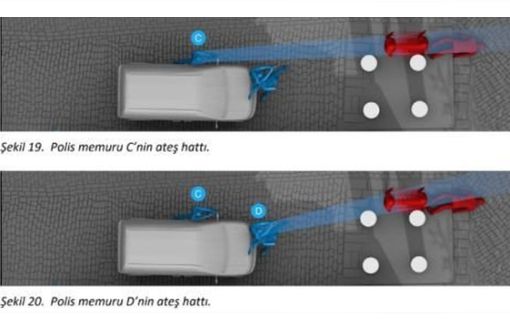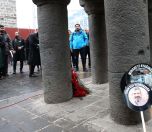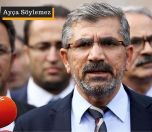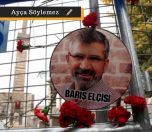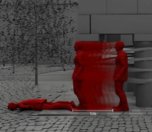* A photo from the Forensic Architecture report
Click to read the article in Turkish / Kurdish
Forensic Architecture, a research agency based in the University of London which has prepared a detailed report on the killing of Diyarbakır Bar Association Chair Tahir Elçi, has criticized the indictment of the trial.
Diyarbakır Bar Association Chair Tahir Elçi was murdered while making a statement for the press in front of the Four-Legged Minaret in Sur, Diyarbakır on November 28, 2015. The trial over the killing of Elçi started five years after his passing on October 21, 2021.
Criticizing the indictment of the case in reference to its own report, Forensic Architecture has tweeted the following messages:
"On 3 March, the trial of Tahir Elçi's killing reopens. But there is a problem with the indictment. It charges the officers we identified, but also charges a PKK [Kurdistan Workers Party] militant, despite our findings showing clearly that he could not be responsible for Elçi's death.
"In his work, Tahir Elçi was a voice for justice. We join with Amnesty International and HRW and many others across the field of human rights in anticipation and expectation of a just and clear-sighted trial."
On 3 March, the trial of #TahirElçi's killing reopens. But there is a problem with the indictment. It charges the officers we identified, but also charges a PKK militant, despite our findings showing clearly that he could not be responsible for Elçi's death. #TahirElçiİçinAdalet pic.twitter.com/nDVoCtmADr
— Forensic Architecture (@ForensicArchi) February 25, 2021
Speaking to bianet about the issue, lawyer Nahit Eren previously talked about the problems of the indictment based on anonymous witness:
"The case against the perpetrators of the killed police officers and that of Tahir Elçi murder are heard in the same file, which is not right. We see the two incidents separately, but the fact that they are both in the same file raises suspicions about whether the prosecution will go on efficiently or not.
"A month before the hearing on October 21, the file took a different course with the unanimous witness statement. The anonymous witness said that the member of the organization committed the murder. It shows that there is an attempt to take this file to another course.
"In fact, the report prepared in London indicated that police officers might be the perpetrators. However, five years after the incident, the Diyarbakır Chief Public Prosecutor's Office, based on the statement of a unanimous witness, wrote the indictment in such a way to suggest that an organization member committed the murder.
How was the research conducted?Diyarbakır Bar Association shared the material regarding Tahir Elçi's killing with the Forensic Architecture. The files included the videos shot by police officers and press members, civilians' and police officers' testimonies, the reports prepared upon the Bar Association's demand and reports prepared by public authorities in Turkey. The Forensic Architecture created a 3D model of the Sur district. The report said the following on this model: "In order to locate Elçi, the PKK members, the police officers, and members of the press in space, we used a technique called 'camera calibration'. "This process estimates the camera's internal optical properties, such as its focal length, barrel distortion, and optical center, as well as external parameters such as the camera's position and orientation in relation to identifiable spatial elements. "Through this process of calibration, we could thus determine the location, orientation, and scale of objects and people within the scene." The purposes of the investigationAccording to the report, the mandate given to Forensic Architecture by the Diyarbakır Bar Association was to determine, using the audio-visual material in the case file, whether it would be possible to: - Identify the time Elçi was killed. - Identify the individuals that could have fired the lethal shot. - Determine whether or not it was possible for Tahir Elçi to have been shot by a long-range weapon fired from outside of Yenikapı street. - Determine whether the PPK members running down Yenikapı Street should be considered suspects in the killing of Elçi. - Determine whether and which police officers at the scene should have been considered suspects in the killing. - Determine whether there was an attempt to offer Elçi with adequate medical aid after he was hit. |
Report said 'police officers are suspects'
Forensic Architecture, a research agency based in the University of London, released a report of its investigation into lawyer Tahir Elçi's murder.
CLICK - Forensic Architecture Report on Tahir Elçi Murder
The report has concluded that three police officers at the scene of the incident are the most likely suspects of the killing.
Diyarbakır Bar Association Chair Tahir Elçi was shot dead during a press statement near the Sheik Matar Mosque in Sur district of southeastern province Diyarbakır on November 28, 2015.
The Diyarbakır Bar Association presented the report of Forensic Architecture to the Diyarbakır Chief Public Prosecutor's Office on December 14, 2018.
The next hearing of the trial will be held at the Diyarbakır 10th Heavy Penal Court on Wednesday, March 3, 2021.
13-second video footage is 'missing'Attorney Mahsuni Karaman said that a 13-second part of the video footage captured by police cameras was missing. He previously announced that Tahir Elçi was shot to death within these 13 seconds. Indicating that the video footage focused on two Kurdistan Workers Party (PKK) militants' running towards the Four-Legged Minaret in Diyarbakır, Karaman said, "All video records continue without interruption, the entire process is seen. The only record missing is the record of the Photofilm Bureau. The footage freezes at the moment when Elçi heard the voice and was startled; the same record starts with two militants' entering the street. We compared the video records, there is a 13-second gap, interruption in that record. Tahir Elçi was shot within these 13 seconds." CLICK - Forensic Architecture Announces Report on Tahir Elçi Murder Forensic Architecture, a research agency based in the University of London, released a report of its investigation into lawyer Tahir Elçi's murder. The report has concluded that three police officers at the scene of the incident were the most likely suspects of the killing. About the indictmentThe indictment was lodged by the Diyarbakır Chief Public Prosecutor's Office on March 26, 2020 and accepted by the 10th Heavy Penal Court on April 3, 2020. While there are five complainants, including the wife of late lawyer Türkan Elçi, in the 40-page indictment, there are four accused suspects, among whom are also three police officers. Police officers S.T., M.S. and F.T. face the charges of "causing death by culpable negligence" as per the Article 85/1 of the Turkish Penal Code (TCK). The indictment demands 2 to 6 years in prison for the officers. Uğur Yakışır, the other suspect, also faces the charges of "wilful killing, killing with eventual intent, opposition to Law no. 6136 on Firearms and Knives, disrupting the unity of the state and integrity of the country, damaging property." The indictment demands aggravated life sentence for Yakışır, who is also accused of murdering police officers Cengiz Erdur and Ahmet Çiftaslan, who were killed on the same day with Tahir Elçi. CLICK - Indictment Against 4 People, Including 3 Police Officers, 5 Years After Tahir Elçi Murder What happened?Tahir Elçi attended a live TV program on CNN Türk hosted by Ahmet Hakan on October 15, 2015. Elçi said, "The PKK [Kurdistan Workers Party] is not a terrorist organization." While the channel was fined 700 thousand lira over these words, Tahir Elçi was detained in his office in Diyarbakır Bar Association and taken to İstanbul on November 20. While the prosecutor's office referred Elçi to court with a request for his arrest, the Bakırköy 2nd Heavy Penal Court released him on probation. A bill of indictment was brought against Elçi on charge of "propagandizing for a terrorist organization." Elçi faced up to 7.5 years in prison. Diyarbakır Bar Association Chair Tahir Elçi was murdered while making a statement for the press in front of the Four-Legged Minaret in Sur, Diyarbakır on November 28, 2015. |
About the Forensic Architecture
Forensic Architecture (FA) is a research agency, based at Goldsmiths, University of London.
According to its website, the FA undertakes advanced architectural and media research on behalf of international prosecutors, human rights organizations and political and environmental justice groups.
In the past, the FA worked with human rights organizations such as Amnesty International, Human Rights Watch, Centro para la Acción Legal en Derechos Humanos, B'tselem, Al Mezan and Migeurop. They have also worked with international prosecutors, international offices such as the UN Special Rapporteur for Counter-Terrorism and Human Rights, and reporters from The Intercept and the Bureau of Investigative Journalism. (AS/SD)




